Most people, when they think of smart homes, think of smart bulbs and smart thermostats. But it’s services like Samsung SmartThings that take all your smart products and mesh them together into a truly connected home.
Let’s take a look at the SmartThings v2 vs. v3 and figure out which smart home controller will give you the most bang for your buck.
SmartThings v2 vs. v3 — About
The SmartThings systems represent convenience and utility across a wide range of smart products. With a recent redesign of their hubs, outlets, and multipurpose, motion, and water leak sensors, SmartThings helps your favorite products work better for you.
With SmartThings, your home products are aware of your schedule. Knowing that your smart systems are aware of your comings and goings, and when you’re awake and asleep, gives you the assurance that your connected home is always poised to respond to your needs. Your SmartThings system knows what you want and what you need better than you do yourself, and with a little bit of setup you can let your home do the heavy lifting and focus on enjoying the increased convenience and utility.
The possibilities for home customization are nearly endless — you just need some extra smart tech.
SmartThings makes it easier than ever before to outfit your home with intelligent tech — just let the hub teach your home the tricks it needs to make your life more convenient.
The company has been around for a while at this point, and has produced three different generations of products that feature varying levels of tech and features: version 1, version 2, and version 3. Version 1 is no longer manufactured or sold through the Samsung store, but you can still buy it on Amazon. Each successive release has made SmartThings a little bit smarter, and below we’ll take a look at Samsung v2 vs. v3 to help give you a sense of which system will work best for your specific wants and needs.
SmartThings v2 vs. v3 — Things in Common
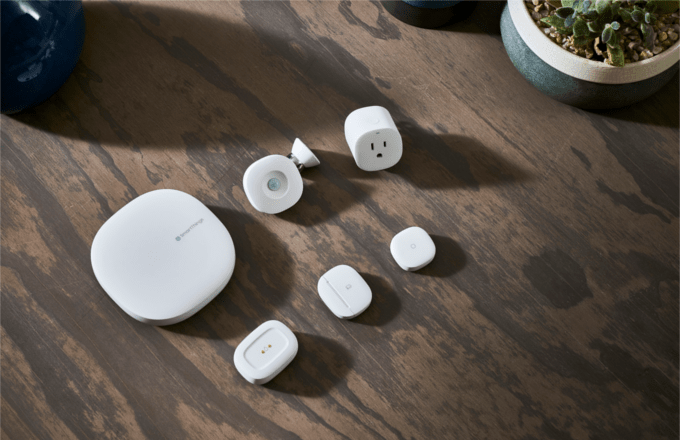
Before we really break the two versions down and get into what makes each one unique, let’s kick things off with a quick discussion on what SmartThings v2 and v3 have to offer at their core.
The primary aspect that makes SmartThings hubs so useful are their connectivity. Regardless of the model you choose, your smart home controller will become the core of your smart home. Connect your products wirelessly across a wide range of brands, and secure, monitor, and control your smart home from wherever you happen to be.
The SmartThing hub supports hundreds of smart home products, and when you have everything hooked up, you’ll have complete control over your home from one convenient app. Applications are available for most major platforms, and you’ll have access to your smart systems from iOS 7.0, Android 4.0, And Windows Phone 8.1 or greater. Do everything from setting personalized schedules and adjusting your sprinklers, to turning on your favorite tunes and locking the front door — all located in one easy location.
Connect to all sorts of different smart locks, lights, outlets, thermostats, and a host of other smart products and receive instant notifications on your phone regarding the status of your home. You can also control pretty much any aspect of your smart technology from wherever you can get online.
Having a smart home is great for all the convenience it can offer, but security is also a major concern for many buyers. From video cameras and door bells, to security systems and smoke alarms, there are a variety of ways that you can keep your home safe with intelligent technology. One of the benefits of SmartThings is its ability to send notifications to your phone when it detects any activity in your home, ensuring you’re always clued in on any movement or other changes in your house’s status.
It goes without saying, but SmartThings offers great integration across a number of different intelligent brands. With support for ZigBee, Z-Wave, and IP-connected devices, there’s an incredibly long list of products that will work seamlessly with your hub. Connect and control products from major brands like Samsung, Honeywell, Schlage, First Alert, OSRAM LIGHTIFY, Leviton, Bose, Cree and more. Regardless of your current smart home setup, it’s pretty likely that SmartThings will enhance the experience and make enjoying your home a more cohesive experience.
Last but not least it’s possible to control your SmartThings hub with compatible voice assistants like Google Home and Amazon Echo.
From your Google Home device, you can adjust the settings of a wide range of connected lights, dimmers, and switches just using your voice. With a simple “Ok Google, turn on the bedroom lights,” or “dim the living room lights,” you can quickly and conveniently adjust light levels.
Other possible voice commands include things like “Ok Google, turn on the bedroom fan,” or “Ok Google, set the thermostat to 72 degrees.”
Google Home support is wide-reaching and you’ll find easy voice activation across the majority of your smart devices — all parsed through your SmartThings hub. Amazon Alexa commands are roughly analogous, giving you a wide range of voice controllers to choose from when building out your connected home.
SmartThings v2 vs. v3 — Differences
- Difference #1: Connectivity to Router – One big change that SmartThings made with the v3 model is the way that the device connects to your router. With the v2 model, you’ll need to connect the hub to your router via the Ethernet port — necessitating a hardwired connection.With the v3, however, SmartThings upgraded the experience and now supports connection to your router via WiFi. This offers you a greater deal of flexibility over where you place your hub, and is one of the biggest advantages that the v3 has over the v2. Testing between the two models generally shows that the WiFi connection is as fast as the hardware method, so there’s really no downside to this perk.
For those who still want to plug their hub into the router, however, that’s still an option on the newest model as well.
If you’re looking for an all-in-one solution to give you a solid internet connection across your entire home while controlling your smart products, we recommend taking a look at Samsung’s new Connect Home mesh router. In addition to providing blazing fast speeds across the entirety of your home, you’ll have the ability to connect and control over 100 compatible smart cameras, lights, speakers, doorbells and more. Samsung SmartThings WiFi is powered by Plume, and learns about your environment and how to optimize it for powerful performance and the ultimate in convenience. It’s the perfect option for those who want one central hub for connectivity, as it offers internet connectivity and smart home support in on handy package.
- Difference #2: Battery Backup – While the v3 definitely has the advantage over the v2 when it comes to connectivity to the router, the v3 is actually a bit of a downgrade when it comes to power options — more specifically, the battery backup.With the v2, your hub is backed up by battery power which ensures it will continue to function normally even if the power were to go out. When Samsung upgraded their model to the v3, however, we lost the capability to rely on that backup.
This feature won’t make much of a difference in day-to-day operation, but if you’re worried about your hub losing the ability to function in a power outage, the v2 is probably the superior choice.
- Difference #3: Range – For most average-sized homes, the v2 and v3 both offer quality service with excellent coverage. However, there is a noticeable difference in the range that each generation of hub has. While the v2 functions in a range of 50-100 ft, the v3 can reach distances of up to 130 ft. For those who have larger homes or are trying to control intelligent products in their yard like a smart sprinkler controller or mower, the extra range may make all the difference and make the v3 the superior voice.
- Difference #4: Design – One of the most immediately noticeable differences between the v2 vs. v3 lies in the differences in design. As with most newer generations of products, the SmartThings v3 hub has a sleeker and more updated look. It ditched the square design for a round construction, and is actually slightly smaller than the v2 at 5.0” x 5.0” x 1.2 “ vs. 4.2” x 4.9” x 1.3”.All in all, while the differences in size are only slight, the v3 admittedly looks significantly better. The ability to place it wherever you want in your home due to the WiFi capabilities also allows you to find the perfect aesthetic fit rather than being tied physically to your router. The v3 is essentially a hub that both looks and works smarter than its predecessor.
- Difference #5: Multipurpose Sensor – One of the main ways in which SmartThings keeps an eye on your home is through multipurpose sensors. These sensors track events like windows, doors, and drawers closing, as well as pretty much any other motion event. When taking a look at SmartThings v2 and v3, both have basic features like vibration, accelerometer, and temperature sensors which gives them a ton of functionality across your home.While both the v2 and v3 have the basic features nailed down, there are some significant upgrades with the newest model that are worth digging into.
One of the most obvious differences between the two models is the actual physical design of the sensors. Just like the brand new hub, the v3 sensors look a lot better. If you stick them on a door, for example, they form a complete circle when they close as long as they are at the same height. This is a much smoother and attractive integration when compared to the much more boxy design of the v2.
Since one of the primary applications of these sensors is to detect their proximity to one another, the stronger magnet on the v3 makes it possible for the SmartThings hub to consider doors closed when the sensors are farther away from one another. This is a notable advantage, as it’s now much more convenient if you need to install the magnets on a deeper door frame. With the v2, you may end up with your SmartThings app telling you that a door is still open despite it being closed, which is definitely an annoyance.Overall, the v3 works with a wider range of doors and windows which definitely gives it an edge.
Also worth discussing is the difference in ease of installation between the two different generations. The v2 relied on a mounting plate which could be a little bit unwieldy to get installed, while the v3 has replaced that plate with simple 3M peel-and-stick installation. It’s now possible to get your sensors up and running with no extra tools or hassle.
Last but not least, while a lot of new products end up more expensive than their predecessors, the v3 sensors actually have a cheaper price than the competition. At roughly 50% of the the price of the v2, it should be much easier to outfit your entire home with sensors wherever you please. Converting a house into a connected home can quickly get pretty expensive, so it’s nice to be able to take advantage of savings wherever you can.
- Difference #6: Motion Sensor – Just as there are some differences in the multi-purpose sensor, there are some upgrades with the v3 from the v2 in terms of motion sensing as well. The SmartThings motion sensors are the primary way that your system can keep an eye on your home and perform actions when motion is detected. Hook the sensors up to your lights to light up a room when you walk in, or activate security camera recording to activate your system when it detects movement while you’re away from home. Motion sensing definitely makes your SmartThings system more smart, and opens up a world of possibilities when it comes to home automation.
In the same vein as the multi-purpose sensor, the v3 SmartThings motion sensor is definitely more useful and less bulky. While the version 2 sensor is large and features the sensor in the upper left corner, the new version has a centered sensor and a more rounded design. It’s both more functional and more attractive, and is an upgrade in every sense of the word.
There has also been a significant upgrade in terms of the mounting. The version 3 motion sensor has a more functional and more easily adjustable mount — allowing you to place it exactly where you need to monitor. The mount is essentially a magnetic ball, and you can move it in any direction or remove it at will. This makes it incredibly easy to install the sensor exactly where you want it for motion control where it really counts.
Speaking of installation, the v3 motion sensor also features the 3M peel-and-stick installation that makes the multi-purpose setup so simple.
- Difference #7: Water Leak Sensor – Most people invest in a SmartThings system for the greater convenience and home automation it offers, but the hub is also an excellent way to save money in damages to your home. The SmartThings water leak sensor is the perfect compliment to your faucet or other leaky areas. Especially in older homes, it’s nice to know that you have some top-notch tech safeguarding potentially wet areas to help you catch any leaks in their tracks before they cause significant damage.
The SmartThings v3 does have some upgrades in this area over the v2 that are worth mentioning.
The first significant difference is the inclusion of an additional sensor on top. The v2, unfortunately, can only sense water underneath it while the v3 can alert you of water dripping down before it hits the ground. Having that extra warning can make all the difference when it comes to protecting your home from significant damage.
As an added benefit, the size of the SmartThings v3 is slightly smaller. While the version 2 sensor was a large flat rectangle, the updated version is shaped more like an oval. The higher edges can pool the water on top of the sensor for increased accuracy and is designed to detect water even when it doesn’t’ land directly on the sensor itself.
- Difference #8: Outlet – Integration with a wide variety of smart products is one of the main selling points of a SmartThings system, but what if you want control over basic appliances too? SmartThings outlets offer the solution by plugging into the wall and making pretty much any device smart. Schedule or automate when the outlet switches the device on or off, and use voice assistants to control your existing technology.
The SmartThings v2 and v3 outlets are priced similarly, but the new outlet has some advantages that are worthy of discussion.
The original outlet has a range of 50-150 feet, while the v3 outlet has a 130 foot range.
As seems to be the trend for SmartThings sensors, the v3 outlet version is slightly smaller and lighter than the original. One of the main detractors of the v2 from a design standpoint is the fact that the status light is awkwardly placed on the side. With the v3, SmartThings moved the status light up to the top which makes for a cleaner aesthetic that makes a lot more sense. Having the smaller size is especially nice for an outlet plug, since it will blend in easier to the rest of your wall and not end up looking nearly as bulky.
- Difference #9: Button – One interesting addition with SmartThings v3 is a new optional button. It’s not too expensive, and has a built in temperature sensor as well which makes it a good value for the price.The new button has three different clicks. By doing a single press, a double press, or pressing and holding the button, you can have your SmartThings hub do one of three different things. What exactly those things are is left up to you, and the system is set up quite similarly to IFTTT. Press the button once, and you can turn off a bunch of lights or turn them back on. You could set up a double press to turn on lights in a specific set of rooms, or make the press and hold turn off all of the lights in your home.
While it’s possible and also quite convenient to adjust settings individually using your smartphone app, it’s always nice to have a physical button to click a few times in order to instantly adjust settings in your smart home. It’s not the optimal solution for fine tuning the details of your intelligent connections, but as a remote to keep by your bed as a quick way to override the existing format, it’s well worth the additional investment.
Unfortunately, the second generation version of SmartThings doesn’t come with a button, so you’ll have to control thing manually through the app or rely on preset schedules. It’s not the end of the world to have to do so, but the v3 definitely still has an advantage in this area.
SmartThings v2 vs. v3 — Comparison Chart
| SmartThings v2 Hub | SmartThings v3 Hub | |
|---|---|---|
| Connection to Router | via Ethernet | via Ethernet or WiFi |
| Protocol | ZigBee, Z-Wave, Cloud-to-Cloud, LAN | ZigBee, Z-Wave, Cloud-to-Cloud, LAN, ZigBee3 |
| Power Source | Battery, Wall-Powered | Wall-Powered |
| Battery Backup | Yes | No |
| Range | 50-100 ft. | 50-130 ft. |
| Color | White | White |
| Dimensions | 4.2″ x 4.9″ x 1.3″ | 5.0″ x 5.0″ x 1.2″ |
| Weight | 7.68 oz | 4.8 oz |
SmartThings v2 vs. v3 — FAQs
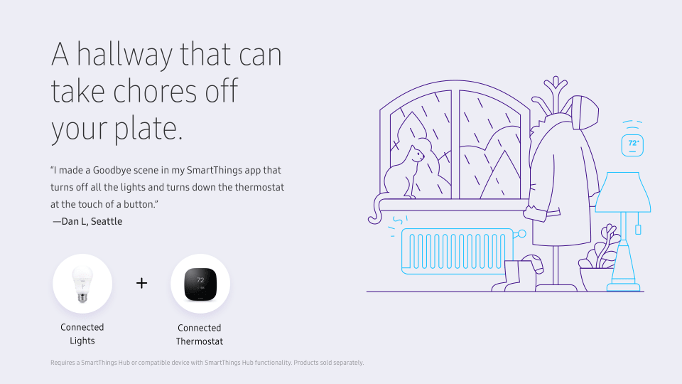
Is There a New App?
With a new product often comes new technology, and unfortunately you’ll have to use a new app for the SmartThings v3. This can be frustrating for those who are already accustomed to the existing SmartThings app, but the new SmartThings Connect program does have a number of improved features. One such perk is the ability to view all your devices from multiple hubs in one list instead of having to toggle between different hubs like you would with the current app.
Unfortunately, there’s a lot to sort through when navigating to a new app, and there will be a whole new learning curve for those who are making the jump from an older SmartThings system to the newest generation. While SmartThings Connect is a clear improvement in a lot of ways, there are still some missing features like custom smart apps. With that said, the old app doesn’t have a way to set up the new hub or program the button. You’ll be making some trade offs either way at this point, but you don’t really have a choice in the matter as the two hubs function through different applications.
In the near future, all features will be migrated over to the SmartThings Connect app and it will become the primary way to control all hubs. That’s still a work in progress, however, so for right now you may be dealing with some growing pains while getting accustomed to the new format.
Should I Upgrade my SmartThings v2 to v3 Hub?
It’s easy to see that there are some advantages with the v3 when compared to the v2, but is it worth the upgrade if you already have the other model? Probably not.
While the v3 offers some cool new features, it’s also going to be quite the ordeal to manually move all of your devices from version 2 and add them in alongside routines back to version 3.
Ultimately, if there are some features with the v3 that you absolutely can’t live without, it’s possible to make the jump to the upgraded model. With all of the hassle you’ll have to go through with removing all smart devices and repairing them in a brand new application, however, it probably isn’t worth the effort.
In our opinion, the disparity between the two models just isn’t big enough to warrant that kind of tedious process.
Can I Just Have Two Hubs?
It may be tempting to just buy a version 3 hub and try to tack it onto your existing version 2, but it’s not quite that simple. The two hubs do not work together, and you can only have one hub that works with all of your devices.
If you’re looking to upgrade your v2 to a v3 hub, you’ll likely have to completely replace the hub.
In most cases, range shouldn’t be an issue in even large homes due to the way that ZigBee and Z-Wave devices function. If you have a lot of smart products spread out throughout your home, they will form a mesh network and extend their reach of your hub across the rest of your house. The signal from one hub and its connected devices should be more than enough to keep your smart technology up and running while connected to SmartThings.
SmartThings v2 vs. v3 — Our Thoughts
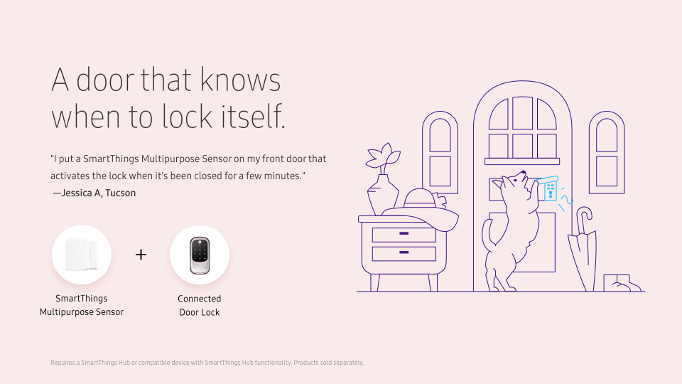
At the end of the day, it’s pretty clear that the v3 is the superior product in every way — but that doesn’t mean you should toss your v2 out and upgrade!
For new buyers, the v3 is probably the superior choice due to the extra range, improves sensors, and increased flexibility due to support for WiFi connection. Alternatively, the SmartThings WiFi mesh router can replace your aging router and function as a smart hub all in one handy device using AI-based networking technology from Plume, so that’s always another option.
For those who are already working with a SmartThings v2 system, however, we recommend just upgrading the sensors and keeping your existing hub. The differences between the two systems isn’t great enough to warrant the extra expense, especially when you consider all the time and effort it will take to transfer your devices and settings from the old app to the new.
Last update on 2024-04-25 at 11:21 / Affiliate links / Images from Amazon Product Advertising API
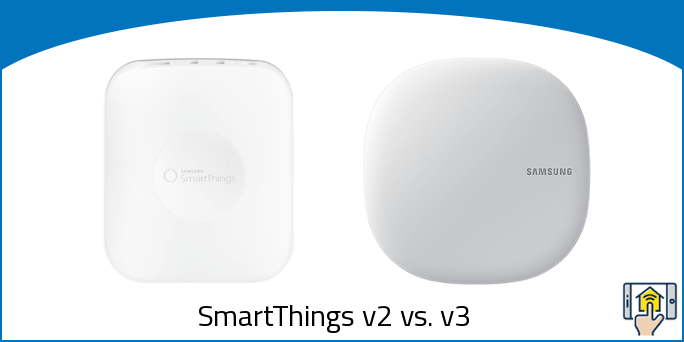


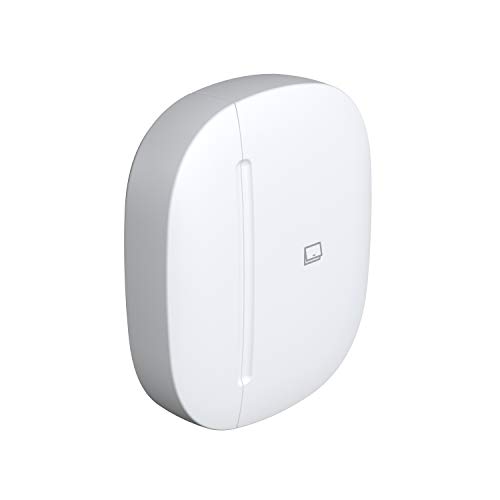
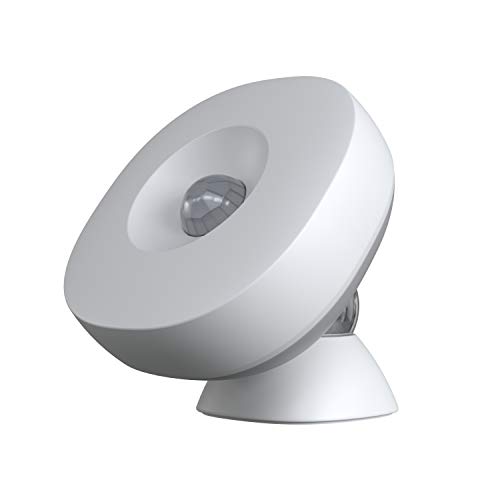




The comment on range is only partially correct. While devices that plug into an outlet (e.g., smart outlets, sirens, etc.) act as repeaters and extend the range, others that are only battery powered such as the multi-sensor, motion sensor, leak sensor and button, do not include that capability, and therefore extended range can be important in many installations. I had to purchase a smart outlet to use strictly as a repeater so I could keep my leak sensor in the basement connected to the hub on the first floor. Please do not minimize the importance of extended range.
What’S about devices handlers……..
With V3 (new App) you have to buy device listed in marketstore
no more product
with V2 (Classic App) you have more choice …the listed ones and the Github ones
Samsung appear to want to take control ….
A lot of device that we can control with smartthings classic app.
are not supported with the new app…..
thoses who love Apple (Simple) will love the new app. (do want we offer)
thoses who love Android (more adventurous) will love the classic app (do want you want to do)
Will the accessories of Samsung SmartThings v2 kit work with V3?
Hi Armando,
Samsung SmartThings Hub Gen 3 is compatible with previous versions of SmartThings Sensors and Outlets.
Cheers! 🙂
Do you know if Genie garage door openers work with Smartthings. If I need an adapter, which one should I use? Thank you…
Will the accessories of Samsung SmartThings v3 kit work with V2?